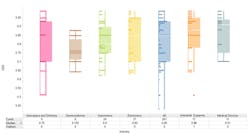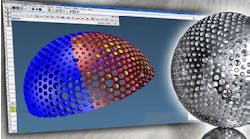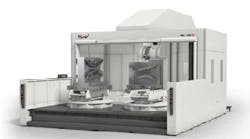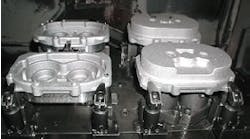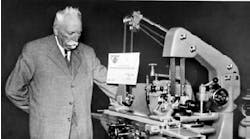It is not difficult to understand why automotive, medical, chemical, micro-component and, especially, aerospace designers love titanium. Its density is only about half of steel, so titanium parts weigh roughly half as much as steel parts. But its high strength — 80,000 psi for pure titanium and 180,000 psi-plus for its alloys — is far greater than the strength of many alloy steels giving it an extremely high strength-to-weight ratio. Titanium has twice the elasticity of steel, making it an ideal choice for applications that require flexible materials that don’t crack or rupture. Also, titanium alloys resist corrosion and oxidation better than stainless steels.
Because of its high strength and light weight, titanium is a favorite with aircraft engine designers. (Photo courtesy Pratt & Whitney.)
Many of the same qualities that enhance titanium’s appeal for most applications also contribute to its being one of the most difficult to machine materials.
However, shops that understand this material’s peculiarities can machine them successfully and cost-effectively.
Most titanium alloys are poor thermal conductors. Heat generated during cutting doesn’t dissipate through the part and machine structure, but concentrates in the cutting area. The high temperatures that can be reached — 2,000°F in some cases — can lead to cutting edge chipping and deformation, and dull edges on tools generate even more heat and further reduce tool life. Cutting temperatures can get so high that titanium chips sometimes burst into flames.
The high temperature generated during the cutting process also causes a work hardening phenomenon that affects the surface integrity of titanium, and could lead to geometric inaccuracies in the part and severe reduction in its fatigue strength.
Machining thin-wall parts
Titanium alloys’ elasticity, which is beneficial and desirable for finished parts, encourages deflection and vibration during heavy machining cuts. Under cutting pressures, the “springy” material moves away from the tool. Consequently, the cutting edges rub rather than cut, particularly in light cuts. This rubbing process also generates heat, compounding problems caused by the material’s poor thermal conductivity.
The 4E turning geometry from ATI Stellram, that has a micrograin carbide substrate and a super hard Nano TiAlN PVD coating, provides positive cutting action to reduce built-up edge in high-temperature titanium machining.
Machining a thin-wall part or ring — common operations — with anything but a positive-rake tool will push and deflect the part rather than cut it. This makes it difficult to cut to size. Instead of cutting the part, the wrong tool pushes it, straining the material. As the material moves away from the cutting edge it deforms plastically, instead of elastically, and that increases the material’s strength and its hardness at the point of cut. As the alloy gets harder and stronger, cutting speeds that were appropriate at the start of the cut become excessive, and the tool wears dramatically.
The alloy the workpiece is made from determines the cutting speed needed to cut it. Unalloyed titanium can be machined at speeds to 180 sfm, while tougher beta alloys require speeds as low as 30 sfm. In general, the more vanadium and chromium in a particular alloy, the lower the cutting speed that is called for. In all cases, titanium alloys demand heavy chip loads to overcome the problem of rubbing and the work-hardening that results.
The magnitude of cutting forces generated when machining titanium is only slightly higher than those developed when cutting steels with an equivalent hardness, even though machining titanium appears to be more difficult and complex.
Flank wear, notching and built-up edge are the common types of tool wear when cutting titanium. Edge notching appears as a localized abrasive wear on both the flank and rake face, along the line corresponding with the depth-of-cut parameter. This wear is caused partially by the presence of a hardened layer that typically is formed by previous casting, forging, heat treating, or prior machining operations.
Chemical reaction between the cutting tool material and the workpiece also could lead to a notching-wear mechanism. This occurs when machining temperatures exceed 800° C., and induce diffusion between the tool and the workpiece.
In contrast, during the machining process, deposits of titanium work materials tend to accumulate on the rake face of the insert. The high pressure developed in this area can weld these particles to the cutting edge, forming a built-up edge phenomenon. These particles, over successively shorter intervals, are inclined to peel off the cutting edge, pulling some carbide content from the cutting insert away with it.
The best tool substrate and coating for machining titanium alloys and super alloys is a submicron substrate that is combined with a physical vapor deposition (PVD) TiAlN coating. The thin, smooth surface of the PVD coating, together with sufficient residual stress, enhances tool resistance to chipping and notching wear, so PVD coatings provide enhanced wear resistance, chemical stability and resistance to built-up edge. Machining problems that were seen in the past that arose from earlier coatings, no longer exist with PVD coatings because of the improved adhesion techniques and the uniformity of the coatings.
Titanium and its alloys
Titanium alloys are available in four varieties: alpha, alpha/ beta, beta and the newer titanium aluminide. Because more alloying elements are being added to the particular grades, these alloys are progressively more difficult to machine.
The Alpha phase of titanium is pure titanium, relatively soft and can be machined at high speeds.
A complicated-shaped jet engine diffuser required ultistage groove-turn operations that removed a large amount of material from solid-ring shaped workpiece. Photo courtesy of Iscar Metals Inc.
This material presents no significant machining problems. However, the material lacks the beneficial properties of the other alloys, primarily strength and flexibility, so its uses are limited.
Alpha/beta alloys are the most common titanium alloys, and Ti-6A1-4V (6% aluminum, 4% vanadium) is used extensively in the aerospace industry, particularly for jet engines. Ti-6A-4V is used to a lesser extent in the medical and chemical industries.
These alloys are moderately difficult to machine, and relatively short tool life can be a problem because alpha/beta chips are difficult to break and are abrasive.
Beta phase titanium alloys do not have the toughness of the alpha/betas, but they are harder and more brittle. They also are more difficult to machine because of the higher percentages of vanadium, molybdenum and chromium with which they are made. Beta phase alloys of titanium are becoming more common, and present serious machining challenges.
Titanium aluminides are very difficult to machine, but they are extremely lightweight and strong. Earlier, a lack of toughness limited their application. However, material science research has addressed their lack of toughness, and applications are beginning to be developed in auto racing engines, where they are used for push rods and valve stems, and in components for jet engines.
|
A strategy for success in cutting Ti • Use positive cutting geometries to minimize cutting forces, heat generation and part deflection. |

